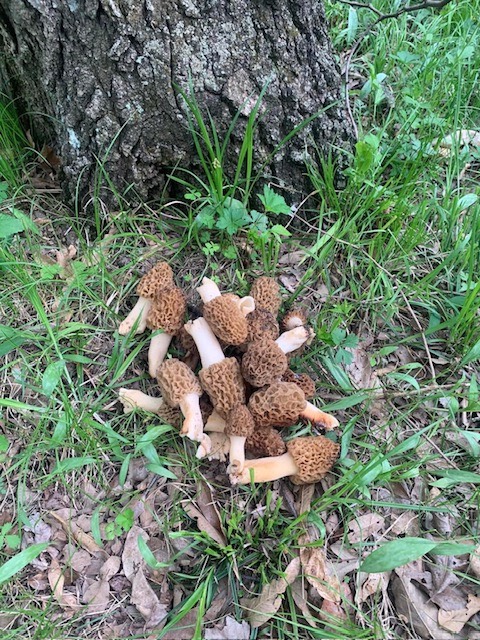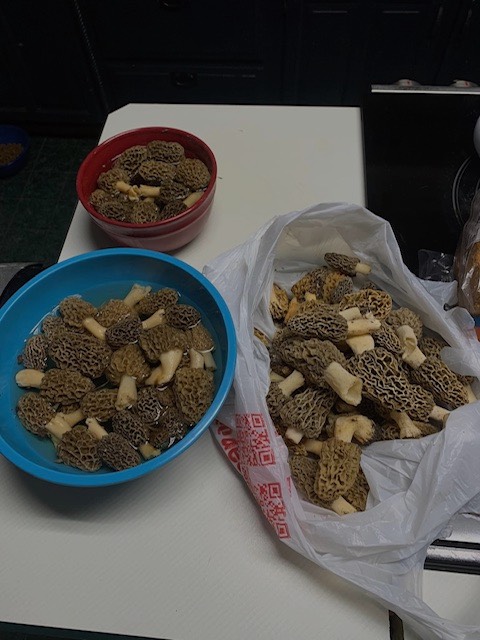Lonnie Cowden
Spring time in Southern Iowa, it’s time for the Spring Grand Slam. shed antlers, wild turkey, crappie, and my personal favorite, morel mushrooms. The morel is the king of all mushrooms, highly sought after.
In my 53 years of life, I have nearly mastered the art of foraging for morels. It’s a family tradition at our house. The secrets have been passed down from generation to generation.
Foraging for morels can be more than a matter of luck. Once you understand the basics, it turns into more of a science. I have used these tricks for years, and always had great success. Follow these simple tips to greatly increase your odds of finding morels in your area.
Where to Find Morel Mushrooms

It’s all about ground temperature. Some people default to a calendar, it’s April and mushrooms should be out. It doesn’t really work that way, you should pay more attention to ground temperatures than a calendar. Morels begin to grow each Spring, when ground temperatures reach 53 degrees Fahrenheit. South facing slopes, and hard West facing slopes, catch the most sunlight. These areas warm up faster than shaded areas, and are the first places to search. Later in the season, check East facing slopes, that only get morning sun. Lastly, North slopes and very shaded areas are the ticket in late season, when other foragers are calling the season over.
Morels need adequate moisture. Mushrooms actually have a water content of 90%. The best time to look is right after a Spring rain. If it’s a dry year, or a drought, concentrate your search along creek banks and River bottoms.
Learn to identify trees. This can be difficult when there are no leaves, but learn to study the bark. Some people claim to have luck around live Maples and Cottonwood trees, but my personal favorite is a dead Elm tree. Not just any dead Elm tree, but one that still has bark attached to it, and the bark is coming loose. This stage in a dead Elm tree seems to produce more morel mushrooms, than any other. It’s definitely on the top of my list for places to check. If I see this type of dead Elm tree in the distance, I will skip all other trees, and walk straight to it. My personal record is over 200 morels under 1 of these perfect dead elm trees.
Avoid the May Apples myth. Morels and May Apples are not linked. Morels and May Apples both grow in similar conditions, and at similar times of the year. That is where the similarities end. I know people who are convinced that there are Morels in every May Apple patch in the forest. This is simply not true. Will you occasionally find a morel near May Apples? Yes, but not consistently, and not as a general rule to target Morels. It’s more of a coincidence than a rule of thumb. As I stated, they do grow in similar conditions. You will have better success by not combing through the impenetrable May Apple patch, and stick with more open areas.
Look for areas with ground disturbance. It seems morels love to grow in these places. I’ve often found big clusters of morels where a tree has fallen, and pulled up the root system when it fell over. Places similar to this can include old fence rows that have been cleared, and areas that have had the undergrowth burned off.
Tips on Spotting Morels
Train your eyes. My Grandfather taught me to carry an old corn cob around with me, and to look at it occasionally. Then try to find that same pattern on the ground. It sounds simple, almost silly, but it definitely helps. In modern times you can also use a photo of a morel on your cell phone, to accomplish the same principle.
Make it easier on yourself to spot them. If you’re standing on sloped ground, looking around a particular tree, stand at the bottom of the slope so you’ll be looking uphill. This is more of a common sense tip. Things are just easier to see when they are positioned in front of you, than they are below the level of your feet.
Don’t get discouraged. Sometimes you’re on the right slope, by the right tree, and they just haven’t started growing yet. It takes the right combination of aforementioned conditions to make it all happen. Don’t be afraid to go back and check that same spot in a few days, especially if you get a rain shower. I’ve picked lots of mushrooms in places that people have already checked prior.
Cleaning and Eating Your Morels

Once I have found a good mess of Morels, I take them home to clean them. I rinse them and slice them in half lengthwise. I always soak them in a bowl of salt water overnight, to kill off any unseen bugs. To store them longer, I drain them, rinse them again, and put them into a zip lock bag in the fridge. They will keep for several days. To preserve morels longer, I start to prepare them with my favorite recipe, but only cook them about half way, then the morels can be frozen.
Everyone has their own favorite recipes for morels. I’ve even seen people put them in spaghetti. That’s not my style, I’d rather taste the morel than the spaghetti sauce. I use the old school method. Simply dip the morel in a little egg wash, roll in flour, and fry in butter until the morel is golden brown. This method is tried and true, nothing better than that in my book.
Happy hunting, and remember to watch for ticks!






























